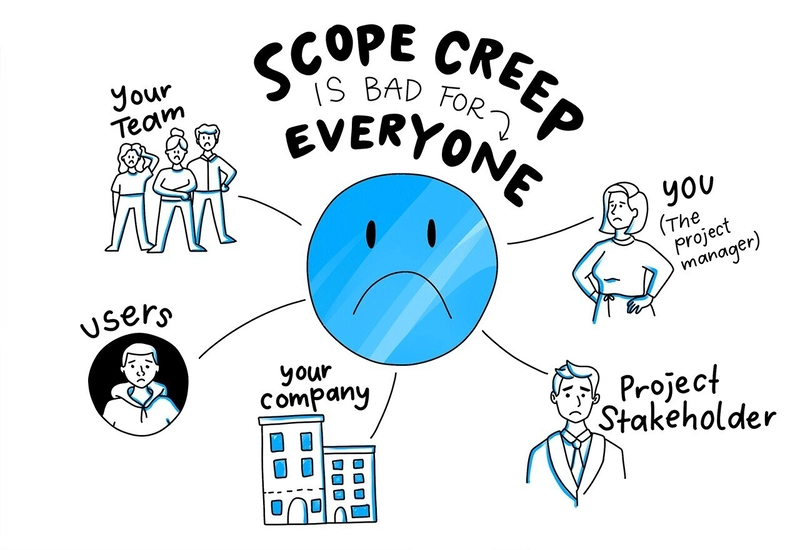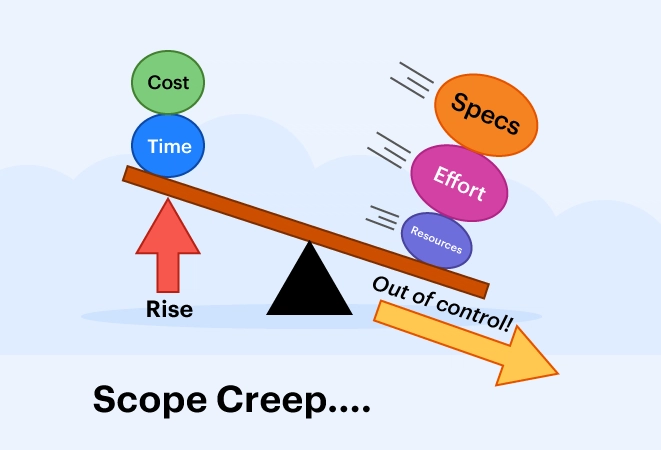Project Scope Creep: What It Is and How to Prevent It in Dev Projects
Introduction Every developer has been there. You start with a clearly defined project, but three weeks in, you're building features no one mentioned during kickoff. The timeline stretches, the budget inflates, and team morale plummets. This phenomenon has a name: scope creep. In this article, we'll explore scope creep, why it's particularly dangerous for development teams, and how to prevent it from derailing your projects. What Is Scope Creep? Scope creep refers to the uncontrolled expansion of a project's scope beyond the originally agreed-upon parameters. It happens when new requirements, features, or deliverables are added to a project without corresponding adjustments to the timeline, budget, or resources. In software development specifically, scope creep often manifests as: Additional features requested mid-sprint Expanding user stories without reassessing timelines Stakeholders adding "just one more thing" repeatedly Undefined or constantly changing requirements While preventing scope creep is crucial, it's equally important to maintain some flexibility. Development projects often benefit from refinement as they progress. The key is managing change rather than eliminating it. Effective teams: Distinguish between scope refinement and scope expansion Build in buffer time for inevitable adjustments Continuously reassess priorities based on feedback Maintain open dialogue about project constraints This balanced approach allows for necessary improvements while preventing uncontrolled scope expansion. Conclusion Scope creep remains one of the biggest challenges in software development, but it's not inevitable. Developing teams can keep projects focused and successful by implementing clear scope definitions, formal change control processes, effective prioritization, and tools. Remember that the goal isn't to reject all changes—it's to ensure changes are intentional, understood, and correctly accounted for in your project plans. With the right approach and tools like Teamcamp to support your processes, you can deliver projects that meet stakeholders' needs without sacrificing timelines, budgets, or team well-being. FAQs 1. What's the difference between scope creep and scope change? Scope change follows a formal change control process with appropriate timeline, budget, and resource adjustments. Scope creep occurs when changes accumulate without these adjustments, leading to project overruns. 2. How do I handle stakeholders who constantly request new features? Implement a formal change request process, educate stakeholders about the impact of changes, and consider implementing a "one in, one out" policy where adding a feature requires removing or deferring another of equal complexity. 3. Can Agile methodologies prevent scope creep? Agile can help manage scope creep through its iterative approach and sprint structure, but it requires discipline. Locking sprint backlogs once sprints begin and deferring new requirements to future sprints is essential. 4. What's the best way to document project scope to prevent misunderstandings? Create detailed documentation that includes specific features and functionality, project boundaries, acceptance criteria, and exclusions. Review this documentation with all stakeholders to ensure alignment before development begins.

Introduction

Every developer has been there. You start with a clearly defined project, but three weeks in, you're building features no one mentioned during kickoff. The timeline stretches, the budget inflates, and team morale plummets.
This phenomenon has a name: scope creep.
In this article, we'll explore scope creep, why it's particularly dangerous for development teams, and how to prevent it from derailing your projects.
What Is Scope Creep?
Scope creep refers to the uncontrolled expansion of a project's scope beyond the originally agreed-upon parameters. It happens when new requirements, features, or deliverables are added to a project without corresponding adjustments to the timeline, budget, or resources.
In software development specifically, scope creep often manifests as:
- Additional features requested mid-sprint
- Expanding user stories without reassessing timelines
- Stakeholders adding "just one more thing" repeatedly
- Undefined or constantly changing requirements
While preventing scope creep is crucial, it's equally important to maintain some flexibility. Development projects often benefit from refinement as they progress. The key is managing change rather than eliminating it.
Effective teams:
- Distinguish between scope refinement and scope expansion
- Build in buffer time for inevitable adjustments
- Continuously reassess priorities based on feedback
- Maintain open dialogue about project constraints
This balanced approach allows for necessary improvements while preventing uncontrolled scope expansion.
Conclusion
Scope creep remains one of the biggest challenges in software development, but it's not inevitable. Developing teams can keep projects focused and successful by implementing clear scope definitions, formal change control processes, effective prioritization, and tools.
Remember that the goal isn't to reject all changes—it's to ensure changes are intentional, understood, and correctly accounted for in your project plans. With the right approach and tools like Teamcamp to support your processes, you can deliver projects that meet stakeholders' needs without sacrificing timelines, budgets, or team well-being.
FAQs
1. What's the difference between scope creep and scope change?
- Scope change follows a formal change control process with appropriate timeline, budget, and resource adjustments. Scope creep occurs when changes accumulate without these adjustments, leading to project overruns.
2. How do I handle stakeholders who constantly request new features?
- Implement a formal change request process, educate stakeholders about the impact of changes, and consider implementing a "one in, one out" policy where adding a feature requires removing or deferring another of equal complexity.
3. Can Agile methodologies prevent scope creep?
- Agile can help manage scope creep through its iterative approach and sprint structure, but it requires discipline. Locking sprint backlogs once sprints begin and deferring new requirements to future sprints is essential.
4. What's the best way to document project scope to prevent misunderstandings?
- Create detailed documentation that includes specific features and functionality, project boundaries, acceptance criteria, and exclusions. Review this documentation with all stakeholders to ensure alignment before development begins.







































































































































































![[The AI Show Episode 144]: ChatGPT’s New Memory, Shopify CEO’s Leaked “AI First” Memo, Google Cloud Next Releases, o3 and o4-mini Coming Soon & Llama 4’s Rocky Launch](https://www.marketingaiinstitute.com/hubfs/ep%20144%20cover.png)















































































































































































































































(1).jpg?#)





-Classic-Nintendo-GameCube-games-are-coming-to-Nintendo-Switch-2!-00-00-13.png?width=1920&height=1920&fit=bounds&quality=70&format=jpg&auto=webp#)

























_Olekcii_Mach_Alamy.jpg?width=1280&auto=webp&quality=80&disable=upscale#)














































































































![M4 MacBook Air Drops to New All-Time Low of $912 [Deal]](https://www.iclarified.com/images/news/97108/97108/97108-640.jpg)
![New iPhone 17 Dummy Models Surface in Black and White [Images]](https://www.iclarified.com/images/news/97106/97106/97106-640.jpg)






































































































































